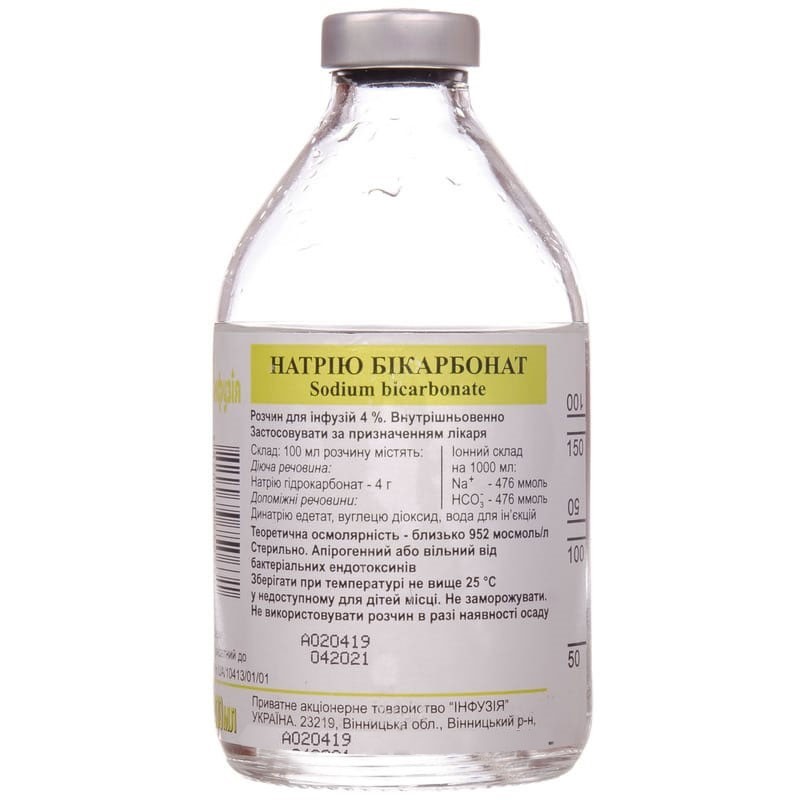



 Secure and encrypted payment processing
Secure and encrypted payment processing We ship to over 40 countries including the USA, UK, Europe, Australia and Japan
We ship to over 40 countries including the USA, UK, Europe, Australia and Japan Guaranteed refund or reship if you haven't received your order
Guaranteed refund or reship if you haven't received your orderThe sodium bicarbonate infusion solution is used for the following indications: uncompensated metabolic acidosis, which can occur during intoxications of various etiologies, severe postoperative period, extensive burns, shock, diabetic coma, prolonged diarrhea, indomitable vomiting, acute massive blood loss, severe liver damage and kidneys, prolonged febrile conditions, severe hypoxia of the newborn. The absolute indication is a decrease in blood pH below 7.2 (normal 7.37-7.42).
The active substance is sodium bicarbonate (100 ml of the solution contains 4 g of sodium bicarbonate).
Excipients: disodium edetate, carbon dioxide, water for injection.
Ionic composition per 1000 ml of the drug: Na+ - 476 mmol, HCO3- - 476 mmol.
Apply the solution, controlling the acid-base balance of the blood. Assign to adults by intravenous or rectal drip; children - intravenously drip. Depending on the severity of acidosis, the drug should be used undiluted or diluted with a 5% glucose solution in a 1: 1 ratio.
Adults enter intravenously at a rate of about 60 drops per minute, up to 200 ml per day. The frequency of administration of the drug depends on the indicators of acid-base balance.
In newborns should be administered in a dose of 4-5 ml per 1 kg of body weight, for children of other age groups - in a dose of 5-7 ml per 1 kg of body weight. Subsequent administration of the drug is determined by indicators of acid-base balance. The maximum dose for adults is 200 ml per day. The duration of treatment is determined by the doctor depending on the indicators of acid-base balance.
There is no experience with the use of the drug during pregnancy or lactation. Prescribe when the expected benefit to the mother prevails over the potential risk to the fetus. Use the drug during lactation is possible only for health reasons.
The drug can be used in pediatric practice.
Data on the ability of the drug to affect the reaction rate when driving vehicles or other mechanisms are not available due to the use of the drug exclusively in a hospital setting.
If the dose of the drug is exceeded, it is possible to develop hyperalkalosis, hypernatremia and hyperosmia, tetanic seizures. If there are signs of alkalosis (convulsions, including manifestations of tetany, agitation, a decrease in potassium and calcium levels and an increase in sodium in the blood, an increase in pH), stop administering the drug and, if necessary, introduce isotonic sodium chloride solution or 5% glucose solution. If there is a risk of tetany, administer 1-3 g of calcium gluconate intravenously to adults.
Nausea, vomiting, anorexia, stomach pain, headache, anxiety, hypertension, convulsions, alkalosis.
Acidic substances (ascorbic, nicotinic and other acids), alkaloids (atropine, apomorphine, caffeine, theobromine, papaverine), cardiac glycosides, calcium, magnesium salts, heavy metals (iron, copper, zinc) cannot be dissolved in a sodium bicarbonate solution, because precipitation or hydrolysis of organic compounds occurs. Do not mix with phosphate-containing solutions.
Store at a temperature not exceeding 25 ° C, out of the reach of children. Do not freeze. Do not use in case of sediment.
Shelf life is 2 years.